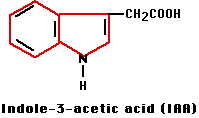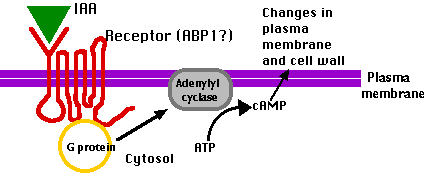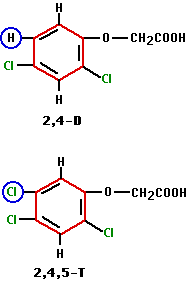Auxins are plant hormones. The most important auxin produced by plants is indole-3-acetic acid (IAA).
 It plays important roles in a number of plant activities, including:
It plays important roles in a number of plant activities, including:
Growth of the shoot apex (terminal shoot) usually inhibits the development of the lateral buds on the stem beneath. This phenomenon is called apical dominance.
If the terminal shoot of a plant is removed, the inhibition is lifted, and lateral buds begin growth. Gardeners exploit this principle by pruning the terminal shoot of ornamental shrubs, etc. The release of apical dominance enables lateral branches to develop and the plant becomes bushier. The process usually must be repeated because one or two laterals will eventually outstrip the others and reimpose apical dominance.
Apical dominance seems to result from the downward transport of auxin produced in the apical meristem. In fact, if the apical meristem is removed and IAA applied to the stump, inhibition of the lateral buds is maintained.
Pollination of the flowers of angiosperms initiates the formation of seeds. As the seeds mature, they release auxin to the surrounding flower parts, which develop into the fruit that covers the seeds.
Some commercial growers deliberately initiate fruit development by applying auxin to the flowers. Not only does this ensure that all the flowers will "set" fruit, but it also maximizes the likelihood that all the fruits will be ready for harvest at the same time.
Auxin also plays a role in the abscission of leaves and fruits. Young leaves and fruits produce auxin and so long as they do so, they remain attached to the stem. When the level of auxin declines, a special layer of cells - the abscission layer -forms at the base of the petiole or fruit stalk. Soon the petiole or fruit stalk breaks free at this point and the leaf or fruit falls to the ground.
Fruit growers often apply auxin sprays to cut down the loss of fruit from premature dropping.
Auxins stimulate the formation of adventitious roots in many species. Adventitious roots grow from stems or leaves rather than from the regular root system of the plant.
Horticulturalists may propagate desirable plants by cutting pieces of stem and placing them base down in moist soil. Eventually adventitious roots grow out at the base of the cutting. The process can often be hastened by treating the cuttings with a solution or powder containing a synthetic auxin.
 The steps appear to be these:
The steps appear to be these:
| Discussion |
| Discussion |
TGTCTC ACAGAG
| See the discussion of glucocorticoid response elements. |

Some of the most widely-used weed killers are synthetic auxins. These include 2,4-dichlorophenoxy acetic acid (2,4-D) and 2,4,5-trichlorophenoxy acetic acid (2,4,5-T).
As the formulas show, 2,4,5-T is 2,4-D with a third chlorine atom, instead of a hydrogen atom, at the #5 position in the benzene ring (blue circles).
2,4-D and its many variants are popular because they are selective herbicides, killing broad-leaved plants but not grasses (no one knows the basis of this selectivity).
Why should a synthetic auxin kill the plant? Auxin (IAA) is actively transported into cells by a transmembrane transporter and leaves the cells by facilitated diffusion through a different transporter. It turns out that the importer works fine for 2,4-D but that 2,4-D cannot leave the cell through the exporter. Perhaps it is the resulting accumulation of 2,4-D within the cell that kills it.
A mixture of 2,4,-D and 2,4,5-T was the "agent orange" used by the U.S. military to defoliate the forest in parts of South Vietnam.
| Discussion of agent orange |
| Other plant hormones | ||||
|---|---|---|---|---|
| Abscisic acid (ABA) | Cytokinins | Ethylene, | Gibberellins | |
| Welcome&Next Search |